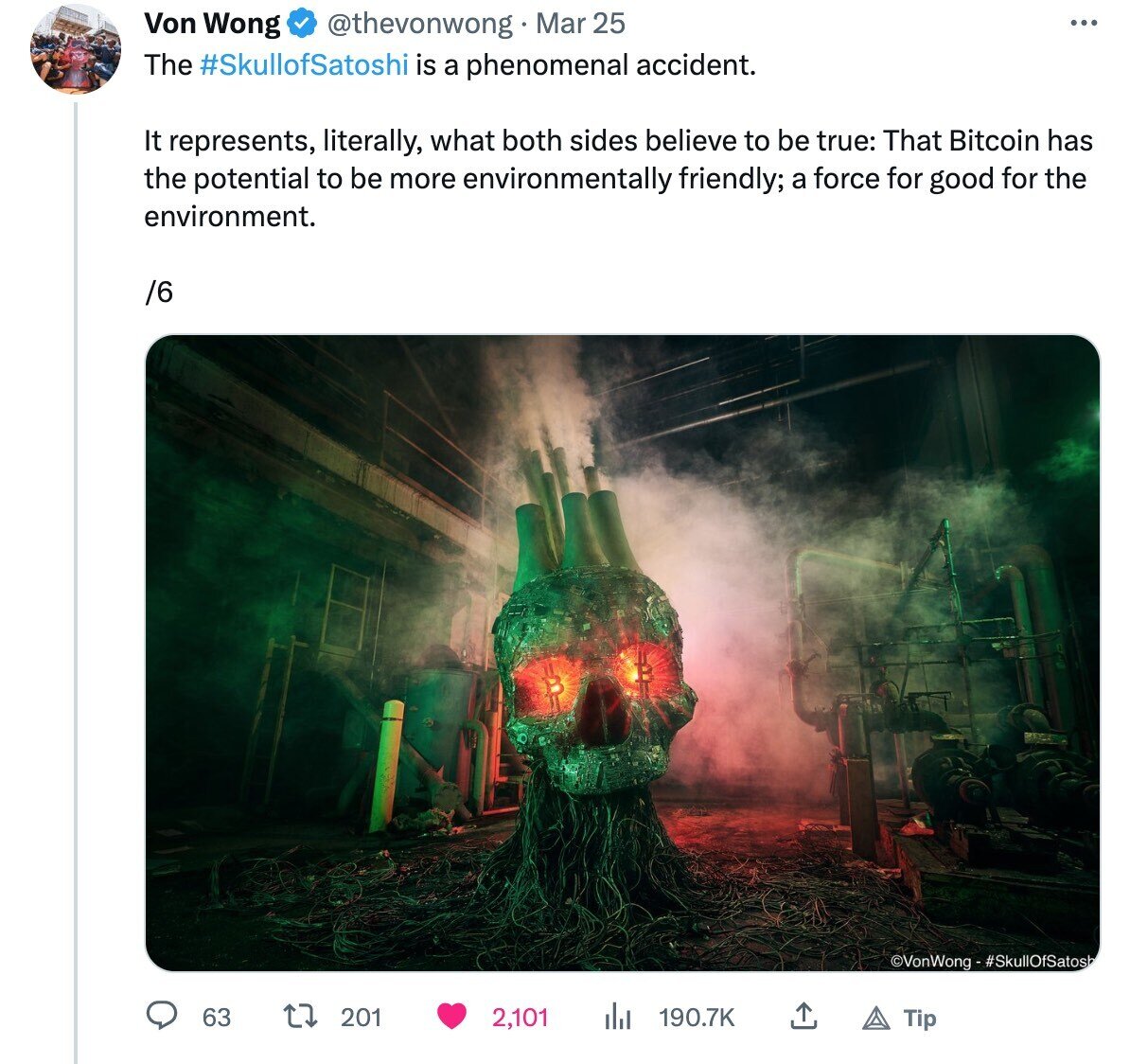- >News
- >How an Anti-Bitcoin Media Stunt by Greenpeace Resulted in a New BTC Mascot
How an Anti-Bitcoin Media Stunt by Greenpeace Resulted in a New BTC Mascot
In late March, Greenpeace launched a media campaign to showcase the negative environmental impact of Bitcoin’s energy use. In more ways than one, the campaign backfired.
The campaign took the form of a video, blog articles, and of course, a giant green skull with smoke stacks coming out the top of its cranium. The skull was aptly named, “The Skull of Satoshi” after Bitcoin’s founder Satoshi Nakamoto.
Upon the unveiling of the skull, Bitcoiners everywhere took to social media platforms in swaths and swarms to educate people who were exposed to the content portraying bitcoin in a negative way.
The result is that the skull is now a sort of mascot for bitcoiners as it says something different than what the artist, Von Wong, was originally commissioned to portray. The story of how it all came together is one worth telling, let’s dig in.
Bitcoin’s Environmental Impact
It is easy to criticize Bitcoin for its insanely large use of energy. It’s been low hanging fruit for environmentalists ever since Bitcoin began “using more energy than the country of Switzerland”. What is often left out of this conversation is what type of energy the Bitcoin network uses and what trends can be observed about Bitcoin’s trajectory.
For example, a fact unbeknownst to environmentalists while towing the “Bitcoin boils oceans” line, is that 58% of the bitcoin network runs on renewable energy. Additionally, because Bitcoin requires energy to run and secure, it is capable of monetizing previously unused or un-monetized energy sources.
An example of this is Virunga National Park in Congo wherein the park was facing bankruptcy. They were able to monetize untapped hydroelectric power to support the cost of running that park. Arguably a positive win for environmentalists everywhere.
The Greenpeace Clean the Code Campaign
Needless to say, there is more to the bitcoin energy conversation than “it uses more energy than country X”. The crux of the anti-bitcoin campaign is about making bitcoin “cleaner”. That is, changing the code so that Bitcoin doesn’t use so much energy.
The idea would be to change the bitcoin codebase so that bitcoin becomes a proof-of-stake blockchain, instead of a proof-of-work blockchain. This idea sounds good on the surface, but bitcoiners will point out several things that give pause to the idea of changing bitcoin’s energy-intensive consensus mechanism.
#1. Anyone can change the code
While it is true that anyone can change the bitcoin code, no one entity unilaterally has the ability to enforce that change amongst all miners.
As seen in the 2017 bitcoin block size wars, a change was made to the bitcoin codebase that was not adopted by the majority of the network. This illustrates the fact that even if someone were to make a PoS version of Bitcoin, it is unlikely to be adopted. This nuance about how changes to the codebase work within bitcoin was omitted, or perhaps not understood by Greenpeace when they built the campaign.
#2. Shifting to Green Energy is Profitable for Mining Bitcoin
Proof of work has numerous second and third order effects that are actually positive for the environment. As pointed out earlier, bitcoin can monetize otherwise unused energy and bring additional revenue sources to hydro, solar, or wind farms.
This allows those operations to maintain and even expand the scope of their green energy operations giving rise to a decarbonization effect. In essence, because bitcoin uses energy, it is allowing us to accelerate the expansion of green energy production.
#3 Legacy Financial System Uses More Energy to Operate
Lastly, it is useful to introduce an apples to apples comparison in order to better understand bitcoin’s energy use. The current financial system made up of brick and mortar banks, printing presses, and servers uses several orders of magnitude more energy than bitcoin (approx 5x – 20x).
We would expect to see similar criticisms waged against the legacy financial system for its energy use, but alas, that criticism has not been made. This points to the idea that this anti-bitcoin campaign is the result of invested interests, which is evidenced by Chris Larson’s (CEO of RippleLabs) funding of the GreenPeace “Change the Code” initiative.
So the clean the code initiative seems more like a disinformation and propaganda campaign, rather than an honest effort to educate the public on bitcoin and its energy use. Surely the campaign administrators, and definitely Chris Larson, know that changing/cleaning the code doesn’t change bitcoin.
Von Wong’s Bitcoin Journey
Embedded within this “clean the code” campaign is the compelling story of the artist behind the Skull of Satoshi, Von Wong. After being featured in an accompanying video explaining his art piece and the story going viral on Twitter, Von began to be engaged by passionate bitcoiners online.
After 48 hours of posting the video, Von posted a tweet announcing his revelation around bitcoin and its environmental impact. He points out and explains some of the more nuanced aspects of bitcoin within his tweet thread and acknowledges that it is not as black and white as the campaign had portrayed.
Source: Twitter
There was an open acknowledgement that bitcoin could actually help us get to a greener future, rather than the opposite.
Skull of Satoshi Becomes a Mascot
Let’s be honest, the Skull of Satoshi is awesome. It’s badass and is clearly the result of a lot of effort, hard work, and passion. It’s a glowing, metallic, ethereal, laser eyed, menacing, enigma wrapped into a glowing green skull.
Source: Twitter. Also see Von Wong’s personal website.
Now, because there is also Von’s personal and redemptive Bitcoin journey attached directly to it, it has come to represent something else for bitcoiners.
In many ways, it has come to be a mascot posing as a reminder of our own bitcoin journey. On the surface, bitcoin looks like it is something that emblemizes and embodies the wasteful aspects of our society.
Deep down Bitcoin is a sleeping green giant.



